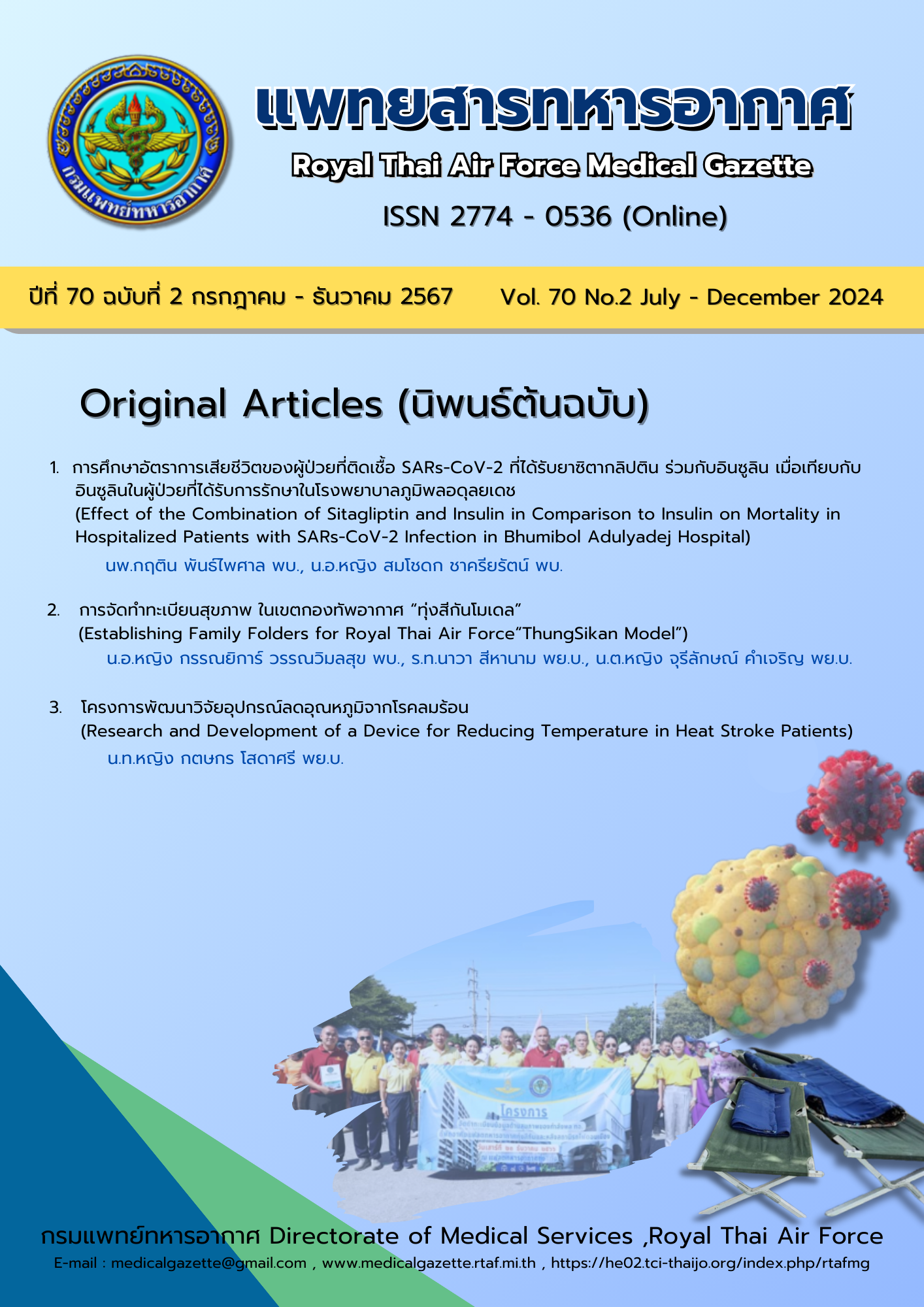โครงการพัฒนาวิจัยอุปกรณ์ลดอุณหภูมิจากโรคลมร้อน
Main Article Content
บทคัดย่อ
ความเป็นมาและความสำคัญของปัญหา: การศึกษาครั้งนี้มีวัตถุประสงค์เพื่อพัฒนาอุปกรณ์ช่วยชีวิตจากโรคลมร้อนให้สามารถนำมาใช้งานได้อย่างมีประสิทธิภาพ และลดอันตราย ลดภาวะแทรกซ้อนแก่ผู้ป่วยที่เกิดภาวะนี้ โดยในผู้ป่วยโรคลมร้อน อุณหภูมิร่างกายจะต้องลดลง 0.2 องศาเซลเซียส/นาที ถึงจะปลอดภัย จึงได้พัฒนาอุปกรณ์เพื่อให้สามารถลดอุณหภูมิร่างกายได้เท่ากับค่าดังกล่าว
ระเบียบวิธีวิจัย: ได้ทำการเลือกกลุ่มตัวอย่างให้ทำกิจกรรมเพื่อให้เกิดความร้อนภายในร่างกาย แต่ไม่เกิดอันตราย จำนวน 17 คน มาทดลองกับอุปกรณ์คือผ้าห่มเย็น และอีก 1 สัปดาห์นัด 17 คนเดิมมาเป็นกลุ่มควบคุมโดยหลังทำกิจกรรมกรรมใช้วิธีเช็ดตัว วิธีการเก็บข้อมูลทำเป็นตารางบันทึกอุณหภูมิ ก่อน - หลัง Intervention ซึ่งบันทึกดูการเปลี่ยนแปลงทุก 5 นาที และได้นำข้อมูลมาวิเคราะห์โดยใช้สถิติพรรณนา (Descriptive Statistics) และใช้สถิติ Chi - square test สำหรับข้อมูลที่เป็นตัวแปรจัดกลุ่ม และ T – test สำหรับข้อมูลที่เป็นตัวแปรต่อเนื่องที่เป็นอิสระต่อกัน และใช้สถิติ ANOVA ในการทดสอบความแตกต่างของอุณหภูมิหลังการทดลองในกลุ่มทดลองและกลุ่มควบคุม
ผลการศึกษา: ระดับอุณหภูมิเฉลี่ย ก่อนการทำ Intervention ของทั้ง 2 กลุ่มไม่มีความแตกต่างกัน อย่างมีนัยสำคัญทางสถิติ ในขณะที่ระดับอุณหภูมิเฉลี่ยหลังทำ Intervention ของทั้ง 2 กลุ่ม มีความแตกต่างกันอย่างมีนัยสำคัญทางสถิติ เมื่อได้นำระดับอุณหภูมิเฉลี่ยที่ลดลงของทั้งกลุ่มทดลองกับกลุ่มควบคุม มาทำการเปรียบเทียบพบว่า การลดลงของอุณหภูมิเฉลี่ยในกลุ่มทดลองลดลงได้มากกว่ากลุ่มควบคุม อย่างมีนัยสำคัญทางสถิติ (p < 0.001) และเมื่อได้พิจารณาจำนวนผู้เข้ารับการศึกษาที่สามารถลดอุณหภูมิได้ ≥ 0.2 องศาเซลเซียส/นาที ก็พบว่าในกลุ่มทดลองมีจำนวน 15 ใน 17 คน คิดเป็นร้อยละ 88.20 ในขณะที่ กลุ่มควบคุมมีจำนวน 2 ใน 17 คน คิดเป็นร้อยละ 11.80 ซึ่งมีความแตกต่างอย่างมีนัยสำคัญทางสถิติ (p< 0.001)
สรุป: จากการศึกษาวิจัยการพัฒนาอุปกรณ์ลดอุณหภูมิจากโรคลมร้อน พบว่าอุปกรณ์ มีประสิทธิภาพในการลดอุณหภูมิร่างกายผู้ป่วยที่เป็นโรคลมร้อนได้ ≥ 0.2 องศาเซลเซียส/นาที ซึ่งทำให้ผู้ป่วยปลอดภัย ไม่เกิดภาวะแทรกซ้อนจากโรคลมร้อน จึงมีประโยชน์ต่อหน่วยงานที่ปฏิบัติภารกิจด้านการแพทย์ทหาร และหน่วยงานที่รับพลทหารใหม่ที่จะนำไปใช้งาน
Article Details

อนุญาตภายใต้เงื่อนไข Creative Commons Attribution-NonCommercial-NoDerivatives 4.0 International License.
บทความที่ได้รับการตีพิมพฺเป็นลิขสิทธิ์ของวารสาร
เอกสารอ้างอิง
เอกสารอ้างอิง
Helman RS . Heat Stroke Treatment and Management. emedicine.medscape.[online]. Available from: URL://http://emedicine.medscape.com
Hifumi T, Kondo Y, Shimizu K, Miyake Y. Heat Stroke. J Intensive Care. 2018;6:30.
ประกาศกรมแพทย์ทหารบก เรื่องคำแนะนาการป้องกันและเฝ้าระวังการปฐมพยาบาลและการรักษาพยาบาลการบาดเจ็บจากความร้อน พ.ศ. ๒๕๕๒
แนวทางการดูแลผู้มีอาการเจ็บป่วยจากโรคลมร้อน (Heat Stroke ) กวป.พอ. พ.ศ. ๒๕๕๗
แนวทางการปฏิบัติการตรวจปัสสาวะแนวใหม่เพื่อป้องกันโรคลมร้อน (Heat Stroke ) ศปพ.พอ. พ.ศ. ๒๕๕๘


